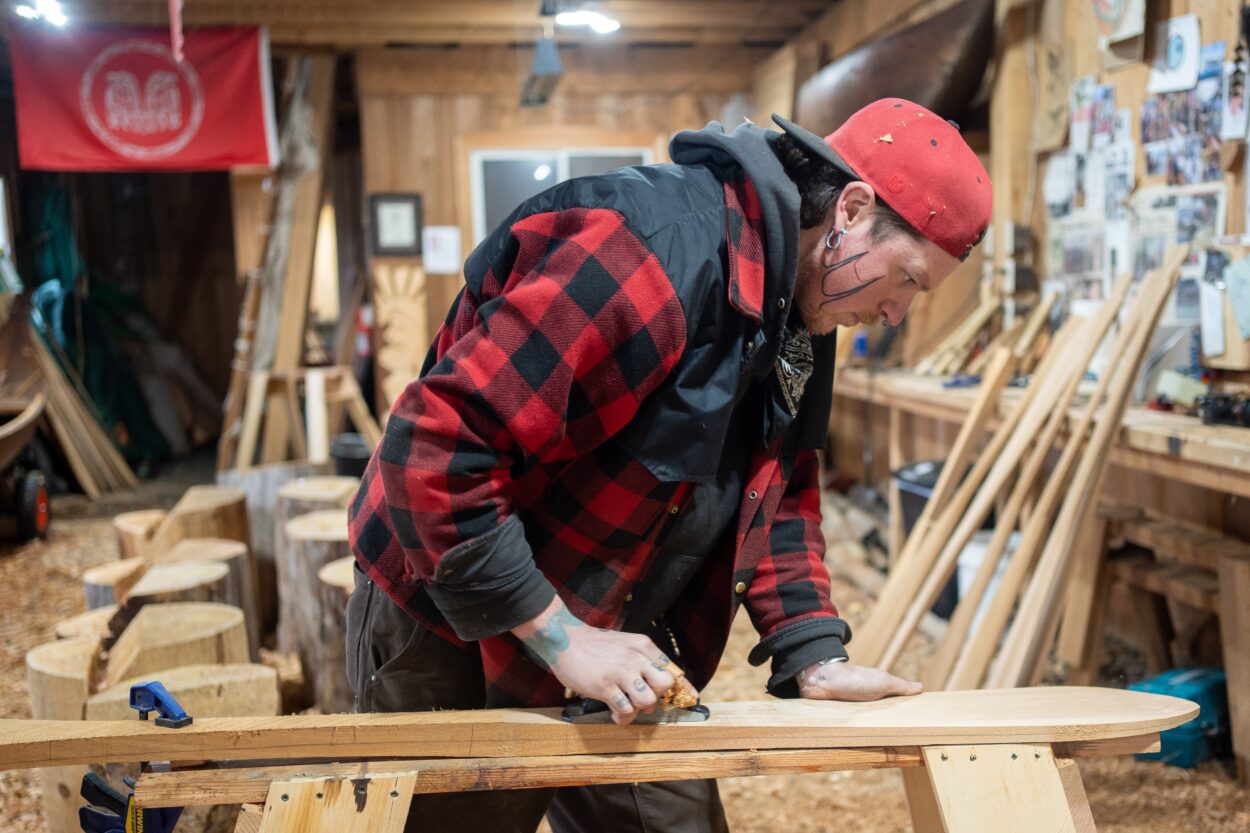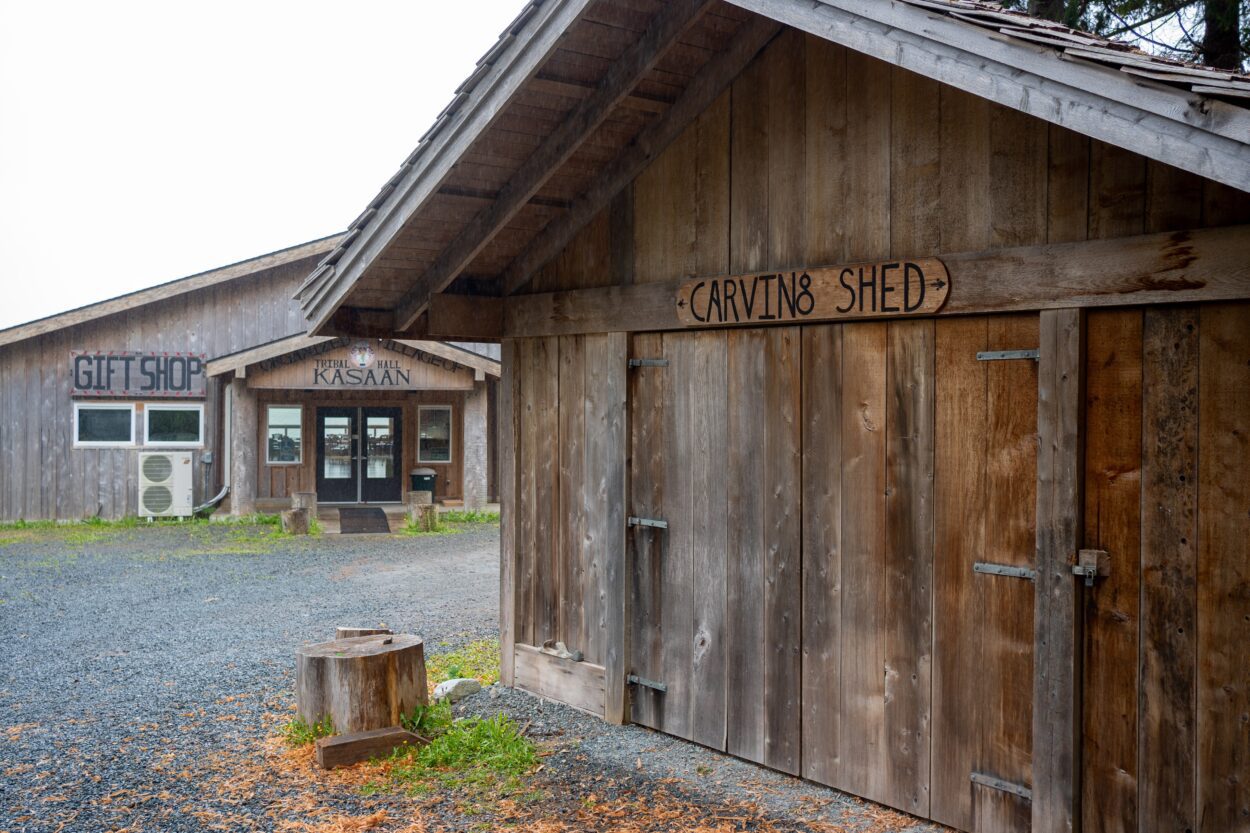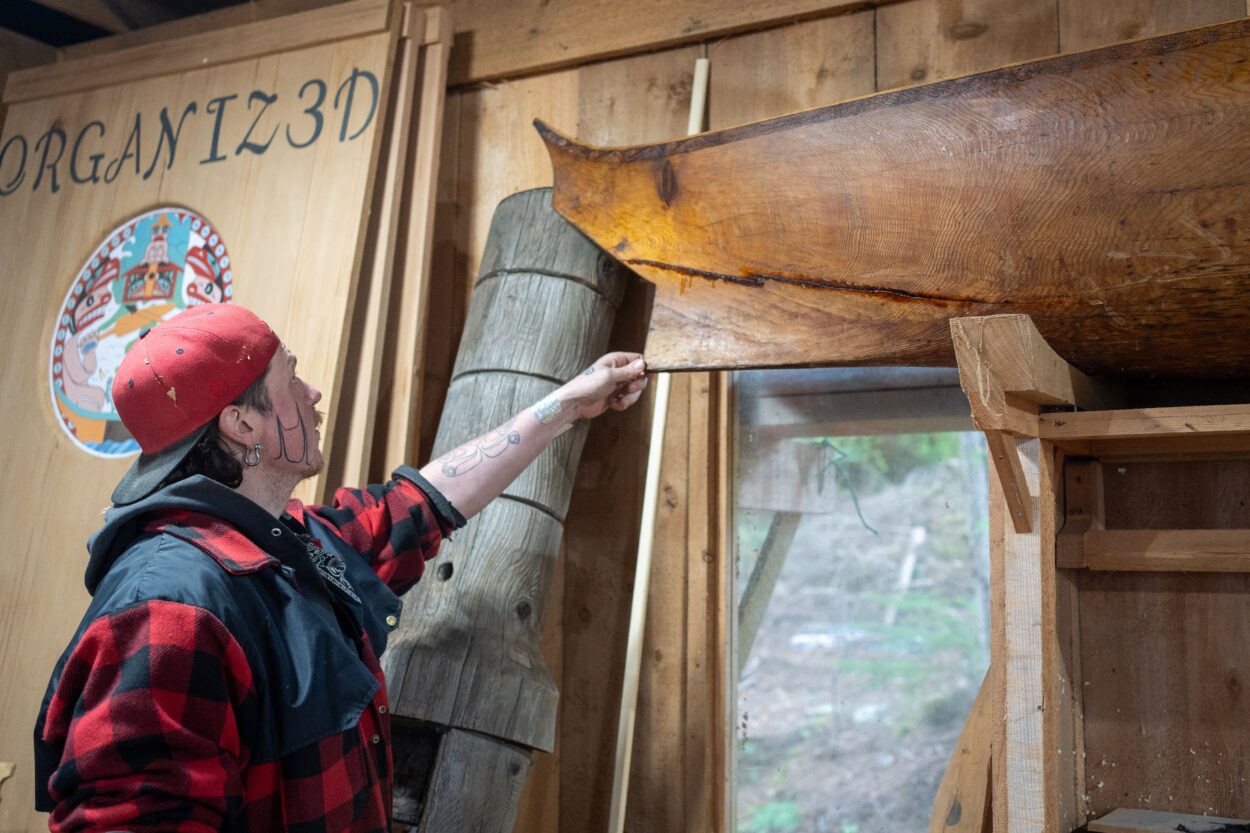
Inside Kasaan’s carving shed in early May, Eric Hamar is hard at work.
Hamar is a Haida artist and carver, and he spends his days carving in the workshop in Kasaan, a small village of about 30 people on Prince of Wales Island. The thick smell of cedar in the air, Hamar’s surrounded by canoes, paddles, a half-carved totem pole, and tools.
On this particular day, he was busy getting ready for Celebration, the huge every-other-year gathering of Indigenous people in Southeast Alaska. The event lasts four days and is the largest gathering of Tlingit, Haida, and Tsimshian peoples in the world.
Hamar’s preparation for the festival is a little more involved than packing socks and a toothbrush. His task at hand was planing wooden paddles.
“Planes are kind of interesting because they’ll chirp,” he said, as he ran a hand-planer tool down the length of the paddle, laughing at its dullness. “But when they’re really sharp, and you run down a piece of wood it goes ‘chirp’ like a bird, which this one is not doing.”
Hamar is part of a group who will set out for a 10-day, 250 mile journey from Kasaan to Juneau, where Celebration is held, in canoes they carved themselves.
According to Hamar, paddles aren’t his favorite thing to work on.
“I like three dimensional stuff a lot more,” Hamar said.
There’s also a large totem pole sitting on saw horses in the corner. He’s been working on that for about a year. It has three watchmen on the top and below that, the beak of a raven juts out.
“[It’s] more exciting for me as an artist,” Hamar said of the totem. “But you know, there’s something beautiful about the simplistic nature of something like a paddle as well.”
Across the room, there is a stack of rough pieces of wood carved into a paddle shape, waiting to be sanded.
“It’s pretty exciting to be going on this journey for the first time in our own canoes from our own community and meeting up with a lot of other communities on the way,” Hamar said as he worked. “I think, hopefully, it’ll bring a lot of inspiration to the people and hopefully get some folks excited about maintaining the traditions.”
Twenty-six rowers plan to depart Kasaan in three canoes. The group is all ages.
“Well, the youngest has to be six months, because that’s my baby,” Hamar laughed.
The carver’s whole family will be joining him on the voyage — his mom and dad, sister and brother-in-law, and his wife and two daughters. One of the girls is six months old and the other is almost six years old.

To get to the village of Kasaan, you turn off the main route that spans Prince of Wales Island and then follow a dirt and gravel logging road for nearly an hour through dense forest and timber operations and then, suddenly, there it is.
To bolster the group, some paddlers will be coming to join them from other communities all over Southeast Alaska, and according to Hamar, a couple as far away as Seattle.
They plan to make stops in Thorne Bay, Coffman Cove, Wrangell, Petersburg and then camp the rest of the way up the coast to Juneau.
There is an 18-foot canoe hanging in the shop. Hamar said that wasn’t one of the ones headed to Celebration. It wasn’t ready yet. The wood of the canoe fanned out but then curled back in on itself like a flower that hasn’t bloomed. Hamar said it needed to be steamed.
“Basically, you just take it down to the beach and you start a big fire and you put a bunch of rocks in the fire. And then you fill [the canoe] up with saltwater. And then you put the hot rocks in there until it starts boiling and cover it with a tarp. And then it just kind of naturally falls open as the wood heats up,” Hamar explained.
Once it’s steamed, the carvers will prop the hull open with sticks so it holds its shape as the wood cools. Eventually, the seats and crossbars — called thwarts — are what will keep the wooden canoe in shape.
Finally, strips of wood are steamed in and riveted to the sides to act as ribs.
“That’s kind of the last step before finishing it with oil and paint or whatever you’re doing,” Hamar said.
Since the canoes are one large piece of wood, they’re prone to becoming overly dried out and splitting. Hamar paints the bottoms with tar to lock in the moisture.
Hamar said making a canoe is a long and difficult process. In his 20 years carving with his dad, he had built just the three hanging in the shed. He said that’s because it’s hard to find the perfect piece of wood. Plus, they aren’t something you can easily sell.
“So then the person who might be using it isn’t actually going to be able to afford it, unless it’s being sold as an art piece, which kind of isn’t the point, right?” Hamar explained, adding that the canoes require a lot of maintenance. But back in the day, people depended on them to get around.
“You [probably] would have had the time to take care of it. It was important,” Hamara said. “It’s now important in a different way, I think. It’s important for the culture and ceremonial use more than anything.”
That’s not to say that the vessels are strictly ceremonial though.
“This one is covered in pine tar, and seal oil, and blood and guts, and it’s pretty beat up and that’s why I like it,” Hamar said, pointing to a canoe he and a friend had used the previous weekend to catch a 250-pound seal. “It looks good that way! Looks like it gets used, because it does.”
Hamar’s work was interrupted by a group of students from Klawock filing into the shed. They were there to learn about sustainable harvesting and the important sacrifices that trees and animals make to provide for them.
“When we’re talking about something like a totem pole, we have to make sure that we’re not only looking after the ones that we cut down and doing a good job to make sure that — that’s why we make them look really pretty,” Hamar told the kids, gesturing at the totem pole next to him. “And you don’t want to kill something and have it just go to waste.”
Hamar isn’t just a carver. He said he loves the carving shed and his work teaching people the traditional ways. But he said that culture and artists should evolve, as well. In his free time, he is working on an art piece commissioned by the Anchorage Museum.
Celebration kicks off June 5 and Hamar had a stack of paddles to finish before his group heads out in late May. They are scheduled to launch on Saturday, May 25.
Get in touch with the author at jack@krbd.org.






